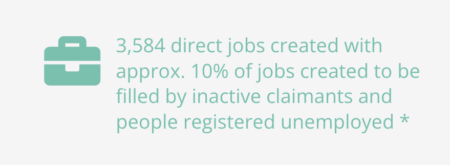Plymouth & South Devon Freeport – That Sinking Feeling
 Almost exactly a year ago South Hams councillors discussed what they believed was a complete and thorough risk audit of involvement with Plymouth and South Devon Freeport (the controversial infrastructure project forced through council and approved with no public consultation). It’s one year later and time to look closely at the assurances of freeport growth and reduced risk. Let’s look at what the freeport’s bringing in terms of ‘Job Projections’.
Almost exactly a year ago South Hams councillors discussed what they believed was a complete and thorough risk audit of involvement with Plymouth and South Devon Freeport (the controversial infrastructure project forced through council and approved with no public consultation). It’s one year later and time to look closely at the assurances of freeport growth and reduced risk. Let’s look at what the freeport’s bringing in terms of ‘Job Projections’.
Plymouth & South Devon Freeport was presented to South Hams Council on 31st March 2022 with the following boast:
“This highly ambitious project has the following anticipated outcomes: 3,584 direct jobs…”
For those of curious minds, this total of 3,584 jobs might seem strangely specific. For the less curious, one might have assumed it was an extremely clever calculation to forward plan ‘anticipated outcomes’ with that level of precision. Unless, of course, there was no precision and no clever calculation…
So let’s unpack this number, get ‘under the hood’ of the freeport and examine what’s really happening: the job numbers ‘on paper’, the job ‘projections’ and the ‘real world’ jobs that someone might actually apply for- today.

First, ‘Paper jobs’:
Richard Howell, Chair of the South Hams Society, has been one of those puzzled by this precise ‘3,584’ jobs number used by councils and freeport on multiple occasions.
In an astute piece of analytical journalism he has carefully examined the jobs case in his article ‘Freeport Fact & Fictions’(pages 7-8) in the July 2024 South Hams Society newsletter. I wholly recommend you to fully read this piece of work. To me it speaks a lesson in what happens when councils fail to apply due diligence to bold claims and question what’s really going on.
To summarise, Richard discovered that this 3,584 number was actually inflated by 1,046 jobs to include indirect jobs that might somehow be created by the Freeport (in an unspecified way). He also revealed that the figure was claimed to have been arrived at through a calculation based on ‘employment density’. Richard writes that this approach works by “taking the average floor-space occupied by each employee in companies involved in similar activities and then dividing the total site floorspace by that average. In other words, if each employee typically occupies 10m2 and the total area of all the premises on the site is 10,000m2, then the number of employees will total 1,000.”
…should we be funding them at all?
In reality, this is little more than a ‘finger in the wind’ calculation, not least because there were no actual ‘takers’ for any of the premises at the time – so nothing really to base it on with any accuracy.
Unfortunately it has been presented to the public as somehow credible.
This guestimate approach makes even less sense when we are talking about ‘logistics and distribution’ planned for these freeport sites. In the real world ‘logistics and distribution’ means warehouses and sheds, however much it might be dressed up for public consumption as ‘flexible workspaces’ or ‘innovation barns’. Rapidly increasing automation means that these warehouses and sheds may span vast areas whilst the number of human jobs within them is in fact tiny. In addition, low paid jobs – not high quality, high skilled jobs- are the bread and butter of logistics and distribution. All in all it signifies ‘made-up’ jobs that may never exist, at a wage level that is not remotely at the ‘high quality’ promised.

Why did the majority of councillors at South Hams fail to even raise an eyebrow in wonder at what that three thousand five hundred and eighty fourth person would actually be doing in the yet to be built, impossibly complicated Kafka-esque construct that is known as ‘the Freeport’?
Also important to note, the same factually dubious figure of 3,584 ‘direct jobs’ is still being promoted on the Plymouth Freeport website.
Additionally, as recently as 18th April 2024 this dubious figure is also being used in documents put to council as a freeport ‘aim’.
Is this misleading?
Is it transparent and accountable?
Having been directly questioned about these highly debatable job ‘anticipated outcomes’, it does seem brass-necked at the very least to continue to promote them without clarification.
Job projections
So now to ‘Job Projections’.
There have been Plymouth Freeport press releases galore, but keen observers may have noted that much of ‘the news’ seems to have been released multiple times before.
Usefully, Plymouth Live has recently drawn together the list of jobs projections in its article “Government ‘badgered’ to recognise Plymouth’s growth potential” (in which freeport representative Cllr Tudor Evans sounds more than a little desperate for even more Government (taxpayer) support for the ailing freeport project).
The article outlines the current Plymouth Freeport jobs PR pitch: that “eight units, in two ‘innovation barns’ earmarked for marine businesses are to be built next year, subject to planning consent…more than £3 million of freeport funding, matched by cash from Plymouth City Council, has been put into the project, and will lead to 49 new jobs.”
In light of the 3,584 debacle, one has to wonder how this figure of 49 new jobs has been reached.
‘Innovation barns’ that are ‘earmarked’ (with currently no names attached) suggests this is part of a ‘build it and they will come approach’, one that brings risk of actually not knowing the real number of jobs that could be created at all. If these are indeed a guaranteed 49 new jobs with real confirmed businesses, surely we should know which companies are involved? Why would that be commercially sensitive and not in the public interest- especially as we, the public is funding their private enterprise premises?
Plymouth Live continues: “Four commercial properties in a single building is due to completed at Langage South next autumn. That area will provide around 138 jobs in defence, marine and manufacturing.”
Once again, we have the now-characteristic lack of specific detail on who those businesses will be: my money is on the fact that this is because there are no confirmed businesses attached. And without confirmed businesses, there are no real jobs, just a press release.
The only current ‘actual jobs’ created by the freeport so far seem to be the ones with Supacat who are working with Freeport anchor tenants Babcock International on production of Supacat’s Jackal 3 military vehicles, said to be creating a total of 90 new jobs.
But all may not be as it seems.
 Jackal vehicles were being built and developed in East Devon at Honiton. Now there is a seeming shift to manufacture them within the Freeport. Why?
Jackal vehicles were being built and developed in East Devon at Honiton. Now there is a seeming shift to manufacture them within the Freeport. Why?
Could it be the amazing tax and customs incentives that the Freeport provides? Is this really new job creation, or in reality a transfer of jobs from one place to another (with more business friendly tax and customs incentives)? What do the workers of Dunkeswell and Honiton think now that production is shifting into the Freeport?
This actually looks like a case of ‘displacement’, an issue that economists have been warning about in relation to freeports for years. Displacement is when businesses outside a freeport area move within it to take advantage of its special incentives, thereby denying tax and jobs to those outside the freeport area. ‘Offsetting’ the enormous costs of displacement is baked into the Freeport model: before the council (and residents) see any return from the Freeport, income will first go to offsetting this issue that it caused in the first place. It’s policy insanity.
There is little current mention of jobs at Langage Green Energy. A big question mark hangs over the business viability of Green Hydrogen, and there are ongoing contractual negotiations over Langage with the Department for Energy Security and Net Zero (see my previous article here). If the site’s developers Carlton Power responded to my questions I would be able to ask them for some precise actual jobs numbers, but sadly they have haven’t responded to my previous requests.
It’s hardly the ‘open and transparent’ Freeport that councils assure residents about, and a failure to respond to public requests for information could indicate a disregard for the millions being poured by taxpayers into these private enterprises. I wonder, if they can’t be bothered to simply respond, should we be funding them at all?
Freeport job losses
A plague of actual job losses – rather than a proliferation of new jobs –characterises Plymouth Freeport. It’s a million miles away from its initial promises of job creation.
A South Hams Freeport Update dated 31st March 2022 trumpeted “an opportunity to create a flagship centre for luxury yacht manufacturing, creating 450 direct jobs”.
In remarkably fawning language for a supposedly impartial council document, the update drooled over how Freeport anchor tenants Princess Yachts “meticulously sculpt some of the most technically advanced and beautiful yachts in the world”.
(How that blatant piece of lobbying was placed into a council document concerns me. Was no-one in the council paying attention?)
Fast forward to 3rd October 2024, and Plymouth Freeport is doshing out further tax payer funds to Princess Yachts: Devon Live reports that “Princess Yachts is to get £315,000 for a project that will enable it to build a new motor yacht incorporating the latest sustainability developments, including efficient hull design, electrification, decarbonisation and sustainable materials.”
Fast forward again, this time to 3rd December 2024, and the news has changed:
Having already made 40 staff redundant earlier in the year, Princess Yachts are now laying off approximately 9% of its workforce, around 250 staff, with 500 jobs under consultation.
In the real world of accountability for public money, I would hope my council would be fearlessly scrutinising this situation. I for one would be asking:
Are we really seeing ‘challenging market conditions’ as Princess Yachts claim from their position of advantageous freeport trading conditions and receipt of substantial public funds? Or are we seeing the inevitable outcome of the company being bought by US Private Equity?
Are these job losses really about ‘streamlining’ to ensure greater profit margins?
Is the average buyer of a ‘meticulously sculpted yacht’ as affected by the cost of living crisis as the rest of us cash-strapped landlubbers? I am to be convinced.
Sadly, judging from the supine fawning of our council documents, I doubt any council freeport representative will raise any meaningful questions beyond the performative to find out.
We’re all being let down by our council, and those hoping for jobs from the Freeport commensurate to the investment of public funds are likely to be sadly disappointed.
Coming next – indefinite delays and diminishing reputation: more risks from the Freeport.

